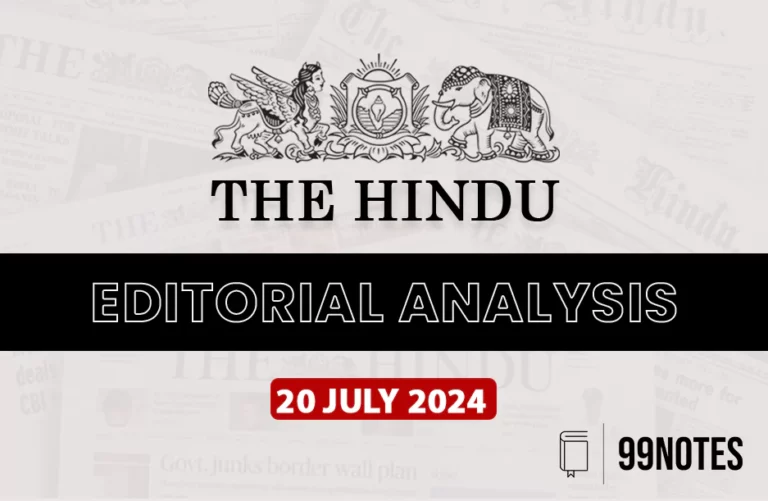18 July 2023 : The Hindu Editorial Notes PDF
The Hindu Editorial
18-July-2023
Daily Current Affairs For UPSC ,The Hindu Editorial Summary
1. There are both risks and benefits in the rupee-dirham settlement system.
Topic: GS3 – Indian economy.
Context:
- The Reserve Bank of India (RBI) and the Central Bank of the UAE have agreed to establish a framework for using the Indian rupee and UAE dirham for cross-border transactions.
- The aim is to reduce dependence on a third country’s currency, such as the US dollar, and promote the bilateral use of local currencies.
- Current account payments, including those involving exporters, importers, and certain capital account transactions, can be settled using either the rupee or the dirham.
More information about the news:
- A Local Currency Settlement System will be put in place, and the payments messaging systems of the two banks may be interlinked in the future.
- The establishment of the settlement mechanism would facilitate the development of a rupee-dirham foreign exchange market, enabling pricing of the two currencies independent of their exchange rates with other major currencies.
Positive outcomes of inter-country currency settlement mechanism:
The establishment of an inter-country currency settlement mechanism, such as the one between India and the UAE, can bring about several positive outcomes, including:
- Reduced reliance on third-country currencies: The use of local currencies for cross-border transactions reduces dependence on a third country’s currency, such as the US dollar. This enhances financial sovereignty and reduces exposure to currency risks associated with third-country exchange rates.
- Enhanced bilateral trade: The availability of a local currency settlement system improves the ease of doing business between the two countries. It eliminates exchange rate risks for businesses and facilitates smoother trade transactions, thereby boosting bilateral trade volumes.
- Increased efficiency and cost savings: Settlements in local currencies eliminate the need for multiple conversions, reducing transaction costs and increasing efficiency in cross-border payments. This can lead to cost savings for businesses engaged in international trade.
- Development of local currency markets: The establishment of a settlement mechanism promotes the development of local currency markets. It can create a market for the exchange and pricing of the respective currencies, allowing for more accurate valuation independent of major global currencies.
- Opportunities for investment and capital flow: The availability of local currency settlement encourages investment between the two countries. It provides avenues for businesses to deploy potential flows of the respective currencies, fostering investment and economic cooperation.
- Precursor for currency internationalization: Inter-country currency settlement mechanisms can act as important initial steps towards the internationalization of a currency. It increases the visibility and usage of the local currency in international transactions, potentially leading to broader acceptance and usage in the global market.
- Strengthened economic ties: The use of local currencies in cross-border transactions strengthens economic ties between the countries involved. It fosters closer economic cooperation, facilitates trade agreements, and encourages bilateral investment, contributing to deeper bilateral relations.
Challenges Associated:
- Adoption and acceptance: The success of a currency settlement mechanism relies on the widespread adoption and acceptance of using local currencies for cross-border transactions. Businesses, financial institutions, and individuals need to be willing to embrace and use the local currencies, which may require significant efforts in terms of awareness, education, and incentivization.
- Currency risks: Despite using local currencies, there can still be risks associated with exchange rate fluctuations between the two countries. Volatility in exchange rates can impact the value of transactions and create uncertainties for businesses involved in cross-border trade.
- Infrastructure and compatibility: Establishing a seamless settlement mechanism requires robust infrastructure and compatible payment systems between the participating countries. This includes the development of payment messaging systems, interoperability of banking systems, and efficient clearing and settlement mechanisms.
- Regulatory and legal framework: Creating a conducive regulatory and legal framework for inter-country currency settlements is crucial. This involves addressing regulatory barriers, ensuring compliance with international standards, and establishing legal mechanisms to protect the rights and interests of parties involved in the transactions.
- Market liquidity: Adequate market liquidity in both currencies is essential for smooth and efficient settlements. Sufficient liquidity ensures that transactions can be executed at fair prices without significant slippage. It may take time for a robust market for the settlement currency to develop, which could initially pose liquidity challenges.
- Market depth and accessibility: The depth and accessibility of the market for the settlement currency can impact its usability. A well-developed market with a broad range of participants, including banks, financial institutions, and businesses, enhances liquidity and facilitates smoother transactions.
- Monitoring and oversight: Effective monitoring and oversight are necessary to prevent misuse, ensure compliance with regulations, and mitigate risks associated with inter-country currency settlements. Regular assessments, audits, and surveillance mechanisms should be in place to maintain the integrity and stability of the settlement system.
Model question: Discuss the significance and challenges associated with the establishment of inter-country currency settlement mechanisms for cross-border transactions. How can such mechanisms promote bilateral trade, economic cooperation, and currency internationalization? What measures should be taken to address the challenges and ensure the effective functioning of these settlement mechanisms? ( 20 Marks)
2. A Bill that fences in the right to information:
Topic: GS2.
Context:
- The Union Cabinet has approved the Digital Personal Data Protection Bill, which will be tabled in the monsoon session of Parliament.
- Concerns have been raised as the final Bill has not been made public despite the draft being available since December 2022.
Why in the news?
- Two provisions in the proposed Bill are causing alarm, as they are seen to weaken the right to information of Indian citizens.
- The Indian Right to Information (RTI) Act, in effect since 2005, is regarded as one of the best transparency laws globally and empowers citizens.
- The RTI Act recognizes the importance of informed citizens, transparency in government affairs, and the role of citizens in holding the government accountable and curbing corruption.
- The Act strikes a balance between efficient governance and democratic ideals, harmonizing the need for a functional government with the principles of democracy.
Tussle between Data Protection Bill and Right To Information:
The tussle between the Data Protection Bill and the Right to Information (RTI) Act arises due to potential conflicts between the protection of personal data and the citizens’ right to access information held by public authorities. Here are some key points to consider:
- Protection of personal data: The Data Protection Bill aims to safeguard individuals’ personal data, ensuring its proper collection, storage, and processing. It provides measures to protect privacy and prevent misuse of personal information.
- Right to Information: The RTI Act empowers citizens to access information held by public authorities, promoting transparency, accountability, and curbing corruption. It recognizes the citizens’ right to be informed and holds government bodies accountable to provide information, subject to certain exemptions.
- Conflict between privacy and transparency: The conflict arises when the protection of personal data under the Data Protection Bill clashes with the citizens’ right to access information under the RTI Act. Balancing the right to privacy and the need for transparency becomes crucial in determining the extent to which personal data can be disclosed under the RTI Act.
- Exemptions and disclosure of personal data: The Data Protection Bill may introduce stricter rules and limitations on the disclosure of personal data, which could affect the availability of certain information under the RTI Act. The exemptions provided in both legislations need to be harmonized to ensure a fair balance between privacy and transparency.
What can be the way forward?
- Striking a balance: It is essential to strike a balance between protecting personal data and upholding the citizens’ right to information. This requires careful deliberation and formulation of provisions in the Data Protection Bill that consider the importance of transparency and accountability in a democratic society.
- Legal clarity and interpretation: Clear and unambiguous provisions in both the Data Protection Bill and the RTI Act are necessary to avoid confusion and conflicting interpretations. Legal experts and policymakers need to ensure that these legislations work cohesively, addressing any potential conflicts in a manner that respects privacy rights while upholding transparency and accountability.
- Public consultation and deliberation: Engaging in public consultation and obtaining feedback from stakeholders, including citizens, experts, and civil society organizations, can help address concerns and ensure that the Data Protection Bill and the RTI Act work in tandem to protect personal data while preserving the citizens’ right to information
Model question: Discuss the challenges in balancing data protection and the right to information in the context of the Data Protection Bill and the Right to Information (RTI) Act in India. Evaluate the potential conflicts and suggest measures to reconcile the provisions of both legislations. (10 Marks).
3. Dispute settlements that have no parallel.
Topic: GS3 – International organisations.
Context:
- The issues surrounding the revival of the World Trade Organization’s (WTO) dispute settlement system (DSS) and the challenges posed by the United States have created significant obstacles.
- Various demands have been raised to stabilise the proper dispute settlement system in WTO.
The way forward can include following measures:
- Defining the appellate body’s role:Address the concerns raised by the United States regarding judicial overreach and the creation of binding precedents. Work towards a precise definition of the appellate body’s mandate and its limitations to ensure that its decisions do not exceed its assigned institutional scope.
- Clarifying the use of precedents: Recognize that international law does not have a formal system of binding precedents like the common law system. However, the appellate body can promote consistency by encouraging reliance on previous interpretations while allowing departures if there are valid reasons. Develop a clear understanding among WTO member countries that appellate body rulings do not create binding precedents.
- Addressing concerns through dialogue: Engage in constructive discussions and negotiations with the United States and other WTO member countries to address their concerns and find mutually agreeable solutions. Seek to understand the underlying issues and work towards practical resolutions that satisfy the interests of all parties involved.
- De-judicialisation versus oversight:Distinguish between de-judicialisation, which aims to weaken international courts and regain decision-making power, and political oversight, which seeks to improve the functioning of the appellate body. Strive to strike a balance that maintains the WTO’s role as a legal framework while allowing for appropriate political oversight to address any shortcomings.
- Exploring alternative approaches:Consider alternative mechanisms or reforms that can effectively resolve trade disputes and maintain the rule of law in global trade. Explore options such as expert panels or independent arbitration to ensure fair and timely resolution of disputes while addressing concerns raised by WTO members.
- Voting for appellate body members:As a last resort, countries can resort to voting at the WTO’s General Council meeting to elect appellate body members. However, this may further strain relations with the United States and should be carefully considered in terms of potential consequences and the willingness of countries to pursue this path.
Conclusion:
Ultimately, finding a way forward for the WTO’s dispute settlement system requires a delicate balance between addressing concerns raised by the United States and other members while upholding the principles of multilateral trade and the rule of law. It will require open dialogue, compromise, and a commitment to strengthening and improving the functioning of the WTO’s dispute settlement mechanism.
Model question: Examine the role of the WTO in the global trade regime and analyze the impact of its dispute settlement mechanism on the functioning of the organization. Suggest comprehensive reforms that can enhance the effectiveness, inclusivity, and legitimacy of the WTO, taking into account the evolving dynamics of international trade and the changing priorities of member countries. (20 Marks)
For Enquiry

18 July 2023 : The Hindu Editorial Notes PDF

18 July 2023 : Daily Current Affairs

17 July 2023 : Daily Quiz

17 July 2023 : PIB

17 July 2023 : The Hindu Editorial Notes PDF

17 July 2023 : Daily Current Affairs

15 July 2023 : Daily Quiz

15 July 2023 : The Hindu Editorial Notes PDF

15 July 2023 : PIB

15 July 2023 : Daily Current Affairs
The Hindu 18 July 2023 : The Hindu Editorial Notes PDF The Hindu Editorial
18-July-2023
Daily Current Affairs For UPSC ,The Hindu Editorial Summary
Facebook-f
Twitter
Youtube
1. There…
Daily Current Affairs 18 July 2023 : Daily Current Affairs DAILY CURRENT AFFAIRS
18-July-2023
Daily Current Affairs For UPSC ,Daily Current affairs of The hIndu…
Daily Quiz 17 July 2023 : Daily Quiz 17 july 2023 : Daily Quiz…
PIB 17 July 2023 : PIB PRESS INFORMATION BUREAU
17-July-2023
Daily Current Affairs For UPSC ,The PIB ( Press Information Bureau…
The Hindu 17 July 2023 : The Hindu Editorial Notes PDF The Hindu Editorial
17-July-2023
Daily Current Affairs For UPSC ,The Hindu Editorial Summary
Facebook-f
Twitter
Youtube
1. India’s…
Daily Current Affairs 17 July 2023 : Daily Current Affairs DAILY CURRENT AFFAIRS
17-July-2023
Daily Current Affairs For UPSC ,Daily Current affairs of The hIndu…
Daily Quiz 15 July 2023 : Daily Quiz 15 July 2023 : Daily Quiz…
The Hindu 15 July 2023 : The Hindu Editorial Notes PDF The Hindu Editorial
15-July-2023
Daily Current Affairs For UPSC ,The Hindu Editorial Summary
Facebook-f
Twitter
Youtube
1. Virtual…
PIB 15 July 2023 : PIB PRESS INFORMATION BUREAU
15-July-2023
Daily Current Affairs For UPSC ,The PIB ( Press Information Bureau…
Daily Current Affairs 15 July 2023 : Daily Current Affairs DAILY CURRENT AFFAIRS
15-July-2023
Daily Current Affairs For UPSC ,Daily Current affairs of The hIndu…




